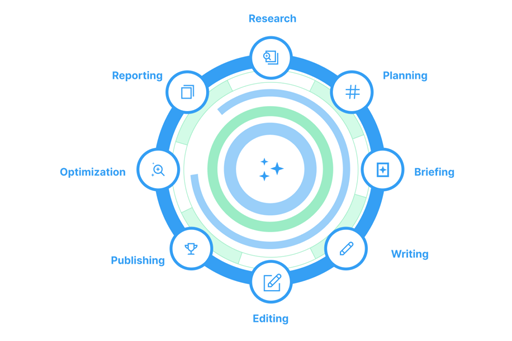Content Marketing in the Insurance Industry
Every Business Needs Great Content
Connect instantly with highly-vetted writers across 50+ industries. Manage your entire content production in one easy-to-use platform. Never worry about content again for your SMB.
Get StartedA fully-supported, flexible content marketing solution for digital and creative marketing agencies. We will match you with highly-vetted writers to best support the content needs of each of your clients.
Learn MoreLarge enterprise businesses in need of a turn-key content marketing solution. Add a dedicated, expert writing team from Scripted to research, produce, and publish premium content.
Learn MoreProducing consistent, quality content on your publishing or media site means managing a lot of moving parts including multiple deadlines, assignments, and payments for freelancers. Scripted can handle it all.
Learn MoreWhy? Because you can’t build trust with someone without communication. Content is your company’s way of communicating with consumers. A content marketing strategy is crucial because you need to communicate effectively. That requires planning.
The problem is that content marketing sometimes feels overwhelming. There are so many details to consider, and where do you even start? What does a content marketing strategy look like? What should it include?
If you’ve pored over guides and outlines but still feel lost in the terminology with no clear direction, you’re in the right place. We've created a guide to content marketing specifically tailored for the insurance industry, complete with real-life examples and statistics. Using the following examples, you can increase organic traffic to your site, and boost your leads and conversion rate.
Content Strategy Objectives

A content marketing strategy should start with clear company objectives. Here are some examples from
insurance companies with successful marketing plans (from a Google search engine ranking standpoint).

Your company exists for a reason. That reason is your mission statement.
Mission statements should clearly define your company’s overall goal. However, they shouldn’t be too long;
one sentence is usually the perfect length.

State Farm is one of the largest insurance companies in the United States. They currently rank fourth in
Google search results for “auto insurance.”
Their mission statement is published on their website:
“State Farm’s mission is to help people manage the risks of everyday life, recover from the unexpected
and realize their dreams.”
It’s effective because it’s concise, clear, and shows the company’s value for its customers.
A strong mission statement is the first step towards creating your content strategy. Ready to write your
own? Remember to answer these four questions:
- What do we do?
- How do we do it?
- Whom do we do it for?
- What value do we offer?

Next, it’s time to create your buyer persona. Put simply, this is a description of your ideal customer(s)
or your target audience(s), and you may have more than one.
The Goal of a Buyer Persona
-
With a buyer persona, the goal is to be as descriptive as possible. You aren’t selling to everyone. You
need to target your content so it speaks directly to the people who are most likely to make a purchase
decision. Who are those people?
Let’s consider another industry leader. You probably remember Allstate from their silly commercials that featured Mayhem,
the villainous character who wreaks havoc on everything and everyone. This was a genius—and very
successful—marketing campaign.
Their site ranks #1 for the keyword “buying car insurance over the weekend.”
Now, Allstate doesn’t post their buyer personas; that’s insider information. But it’s fairly easy to figure
out the target customer profile by looking at this top post. Here’s an example buyer persona based on the
post content:
Mark is a 25-year-old young professional with an average salary of $40,000-50,000 per year. He’s never
purchased a car before, and he has questions about the car buying process. He specifically has questions
about insurance. How does it work? What kind of coverage does he need? He’s smart, but he lacks experience.
He needs a trusted insurance company to help walk him through the process.
The referenced blog post could be targeting a number of customer profiles, but this is just one example.
Mark is likely to search the internet for help with long-tail keywords, such as “buying car insurance over
the weekend.” He’s not exactly sure which questions he should be asking, so he uses this phrase to give
him ideas. He sees the post about car insurance, and thinks, “Hmm, maybe I should learn a little more about
that.” And that’s how Allstate gets a new reader, and possibly a new customer.
Creating Your Buyer Persona(s)
There are several effective strategies for creating your buyer persona. You can look through customer
records to find trends in your demographics (e.g. most of your customers are female, within the 30-50 age
bracket, have a low salary, etc.).
You can also start the task from a different perspective. Think about the customers you want to sell to
most. Who would benefit most from your services? Which customers will spend the most money? Which ones
are most likely to become long-term or recurring customers?
If you need more help, Hubspot offers a free template
that walks you through the process.
Understanding the Buyer’s Journey

Once you’ve created your buyer persona, it’s time to consider things from the customer’s point of view.
More specifically, let’s walk through each step of the buyer’s journey. Experts agree
that there are three primary stages of this journey:
Awareness -
First, the buyer becomes aware of your company and its products or services. This is where your initial
point of contact comes into play, which is usually a blog post, infographic, or video.
Consideration/Evaluation -
Once they’re aware, the customer starts a research process so they can consider or evaluate your company
and its usefulness. At this stage, they may read additional blog posts, then move towards more information
about your company. Your site’s core pages (About, Our Services, etc.) are most important here.
Decision/Purchase -
Finally, the customer makes a decision: they either purchase or decide to go another route. This is why
your contact information should shine. Your phone number or email should be bold and center-stage. Contact
forms are also a great idea. Make it easy for your buyer to make a purchase.
The Goal of Outlining the Buyer’s Journey

Some buyers never make it to the decision stage. Instead, they do research until they forget about the
task altogether. Your goal is to help the buyer move through each stage until they make a firm decision.
How? By using your content strategy.

Let’s consider Mark, the buyer persona we created earlier for Allstate.
Mark’s journey is fairly straightforward:
Awareness:
He wants to buy a car this weekend, but feels uninformed. He searches “buying car insurance over the
weekend” for additional guidance. He finds Allstate’s blog post “Buying A Car This Weekend? Learn How
to Get Your New Vehicle Covered.” (Allstate’s on-page SEO strategy works perfectly here—more about that
later.)
Consideration/Evaluation:
Mark reads the post and decides it’s helpful information. He wants to see what else Allstate has to say
about buying insurance for a new car. He reads a few more posts and finds them helpful and informative.
Decision/Purchase:
Mark buys his car that weekend and remembers Allstate’s advice during the process. He decides that he
would like to have a local insurance agent he can call with questions in the future. Because Allstate’s
blog posts were so helpful, he trusts the company and hopes they can assist more in the future. He uses
the Allstate website to find a local agent, asks for a car insurance quote, and signs up for insurance
on his new vehicle.
If you read through our sample, you may start to see the different points of contact between Mark and
Allstate’s content. This should give you ideas of the type of content Allstate would use to help Mark
make a purchase decision.
You can use the three steps to create a buyer’s journey scenario for your own buyer persona. This
exercise helps you create your content strategy, which targets customer interactions throughout the
three stages of the buying process.
Designing Your Content Framework

Now that you have clearly defined company objectives, it’s time to move to the next stage of creating
a content strategy: making your content framework.
This process helps the content production process run more smoothly. Most companies hire professional
writers, or a team of writers, to create blog posts, emails, etc. The elements of your content framework
ensure that your writers take a uniform approach and follow the objectives you’ve outlined in your
strategy. It’s efficient, and it streamlines content production.

First, consider creating a style guide. This step isn’t absolutely crucial, but if you want your content
to look or flow a certain way, your writers and marketing team need to know that information.
A style guide can be as simple or comprehensive as you like. You can include your mission statement,
buyer persona, and specific details like color scheme, typography, and image guidelines.
Using this post from Geico’s insurance blog,
here’s a sample style guide they might offer their content writers:
Color Palette: Blue, darker blue, and black (#007cba, #005a85, #222222)
Editorial stylebook: Associated Press (AP), but prefer serial commas
Tone: Casual but authoritative
Typography: Lato font
Image sizes: 400x600

You should also have a universal list of keywords handy to target within your blog posts. Ideally,
you will do a bit of keyword research that’s specific for each post topic. This helps your Search
Engine Optimization (SEO), which boosts traffic to your website. But a “master” keyword list is also
a good idea.
SEO Strategies -
SEO strategies change frequently based on Google’s latest updates. However, there are three primary
types of SEO strategizing:
On-page SEO -
On-page SEO is the most directly-related to your content. This refers to the keywords you use within
the text and information on your site.
Technical SEO -
Technical SEO refers to the optimization within the backend of your site. This is usually part of the
web developer’s services.
Off-site SEO -
Off-site SEO relates to the relationship your site has with other sites on the web. Backlinking and
guest posting are two of the post popular off-site SEO strategies.
On-page SEO is the most important part of digital marketing, so that’s the type of strategy we’ll
cover here.

For this example, let’s use the same Geico post from earlier. By analyzing the text, target keywords appear to be:
- Driving at night
- Safety tips
- Driving tips
- Driving safety tips
- Fatal crashes
- Defensive driving
- Defensive driving tips
- Defensive driving safety tips
- Nighttime driving
- Driving fatalities
- Lights for driving at night
- Interior lights
- How to drive safely at night
You might notice these keywords don’t constantly appear throughout the content. Many marketers
mistakenly believe that keywords should appear a certain number of times for SEO purposes.
That practice is called “keyword stuffing,” and it’s usually not a good idea. Google prioritizes
helpful, conversational content over robotic text or filler content. While you should certainly use
keywords often, they should fit within the content without feeling awkward or forced.
You might also notice that a single keyword is actually made up of multiple words. These are called
“long-tail keywords,” and they’re the recommended practice.
Why? For one, Google seems to prefer them. But it’s also easier to rank for longer keywords than
shorter ones. You might have a hard time ranking highly for “insurance” because there are so many
other insurance companies out there. But a longer keyword, like “family-owned auto insurance company
in Oklahoma” is a much easier target.
Believe it or not, there are people who search for these longer keywords. In fact, most people are
going to be more specific with their searches because they’re looking for specific information. You
can use tools like Google Search Console
to find more target keywords that are specific to the insurance industry.

Now it’s time to dive into the fun stuff; let’s brainstorm some blog post ideas.
We say “brainstorm” because you don’t need to get bogged down in the details right now. Instead, take
a look at the information you’ve already created for your content strategy.
Using your buyer persona, buyer’s journey, and mission statement, make a list of as many blog post
ideas as you can within a set timeframe. (We recommend 30 minutes or so.) Don’t edit your thoughts;
you can always tweak the ideas later.
If you need help getting started, here’s a list of the Top 10 Insurance Industry Websites by Organic Traffic.
You can peruse their blogs to see the types of posts they include. As a bonus, we’ve included each
site’s target keywords, too.
How Many Blog Posts Should You Have Each Week?

It’s the number 1 question when it comes to blogging: How many blog posts should you have each week? Most
experts agree that more is almost always better.
But – and this is crucial – quality and consistency are more important than frequency.
In other words, it’s much better to have five helpful, authoritative, high-ranking blog posts than ten
short, filler posts.
You should also take the time factor into account. According to Hubspot,
it takes an average of 1 to 2 hours to write a 500 word blog post (which is a fairly short post; longer
posts will obviously take more time). Time is money, so a higher volume posting schedule will obviously
cost more of your marketing dollars.
What is an Editorial Calendar?

The editorial calendar is the last part of your content framework. This is a simple calendar that helps
you plan out your posting schedule. It should include the post title, target keyword, and the date you
plan to publish the content. You might also include the time of publishing if you’re posting more than
one item per day.
Here are some examples based on the Allstate blog:
1) "How to Replace Your Social Security Card”
Target keyword: replacement Social Security card
Date: September 21, 2020
2) “What’s the Difference Between Premium and Unleaded Gasoline”
Target keyword: difference between premium and unleaded gasoline
Date: June 10, 2020
3) “What Is the Difference Between a Sunroof and a Moonroof?”
Target keywords: difference between a sunroof and a moonroof | moonroof vs. sunroof
Date: January 31, 2020

When you’re making an editorial calendar, it’s best to plan at least one month at a time. This lets you
see the big picture so you’re better able to meet your content strategy objectives.
Some companies plan a quarter's (or even a year’s) worth of content at once.
We recommend starting with a month and adjusting later if necessary.
You can use anything to keep track of your calendar. A plain wall or desk calendar works well, but you
should always have a digital backup. Trello is a great organizational
option, but simple apps like Google Calendar or your
smartphone calendar also work.
Of course, if you have more than one member of your team, everyone will need access to the editorial
calendar so you stay on the same page.
Content Strategies

Now it’s time to post your content. There are certain strategies you should consider to help streamline
this process and make the most of your marketing budget.

It takes time and money to post content. You can cut both by using an efficient strategy: repurpose your content.
How does this work, exactly? Well, you can take a blog post and turn it into a video. Use the key points
to make an infographic that’s easily shared across social media channels. Use little snippets from the
blog text to create Facebook posts or Tweets. You can even use a short sample of the blog content within
a marketing email, then link to the blog post to keep readers engaged.
It’s cheap, it’s easy, and almost everyone uses this strategy.

Most blog posts seem to fall between 500 to 1,000 words or so. But have you ever read a post that seems
more like an eBook? These longer posts are called “pillar pages.”
Pillar pages are usually much longer than typical blog posts—2,000 words or more
(sometimes a lot more). They also tend to rank higher on Google and position your company as an authority
on the subject.
You don’t need a lot of pillar posts, but it’s good to keep a few on your site to help your SEO and keep
your audience interested.

Pillar pages also help with our next strategy: topic clusters.
Topic clusters are groups of posts that all fit one specific topic. These are a great idea from a marketing
standpoint because you can link the pages to each other, which keeps your audience interested and more
likely to make a purchase.
Topic clusters also work well with pillar pages. How? You can use a pillar page as a comprehensive guide
to a specific topic. Then link to shorter posts that are related to that topic throughout the pillar page.
You can create enough content to keep a reader on your site for hours using this method.
Here’s an example
of a topic cluster on State Farm’s site.
They have a group of posts under one heading called “small business.” You can scan through the list to find
an interesting post. Once you’re done reading that post, you’ll find similar posts linked at the bottom
with images. State Farm also links to additional posts within the post itself. It’s a common marketing
strategy because it’s easy and it works.
Measuring Your Content Performance

After you post your content, it’s time to measure its performance. There are different methods you can
use, but it’s easiest to use your Customer Relationship Management (CRM)
software and Google Analytics. (If you don’t
have either one, you’ll want to set those up before you start posting blog content.)

Google Analytics and CRM software track a lot of information, but you don’t necessarily need all of it. Here are the most popular performance metrics:
- Traffic: Users, Pageviews, and unique pageviews
- Conversions or conversion rate
- SEO performance: clicks, impressions, search volume, and SERP ranking
- Consumption metrics: behavior flow and average time on page
- Engagement metrics: inbound links, session duration, and CTR (click-through rate)
- Retention metrics: bounce rate, return rate, and pages per visit
- Cost per blog post
- Leads: number, quality, funnel conversion rate
The metrics you use depend on your goals. Most companies use all the ones we’ve listed, though, because the primary goals of any marketing strategy are the same: to increase revenue by driving traffic and converting new leads.

You should regularly evaluate your site’s performance to see how your posts are ranking and converting.
Don’t get too hung up on it at first, though. Most blog posts don’t perform well until your website has
at least 55 to 70 posts
or so – sometimes more.
You should concentrate your efforts on getting these first posts published, then see how things look. If
your performance is good, then keep doing what you’re doing. If not, consider tweaking your content
strategy to see if things improve. You might also consider doing some A/B testing
to compare two different methods and see which one works better.
How Scripted Can Help Your Content Writing Strategy
When it comes to content, Scripted’s team of writers are experts. We work with you throughout the content
creation process, from brainstorming ideas to optimizing keywords and driving more traffic to your site.
While our system is seamless and efficient, it’s also a great way to build a team of writers you can
work with again and again. We have various subscription levels and our Cruise Control option lets you
sit back while we create your strategy and content. Ready to get started? Reach out to Scripted today
and start your 30-day free trial.



